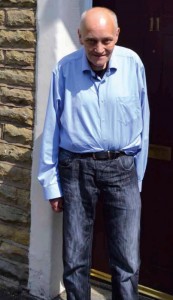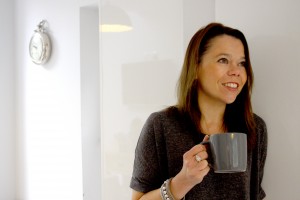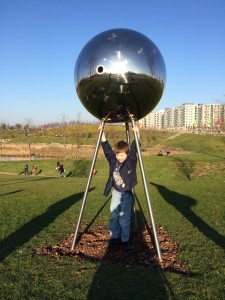
Gary (pictured) shares his osteoporosis experiences in the UK National Osteoporosis Society’s ‘Life with Osteoporosis: The Untold Story’ report
To look more closely at the risks surrounding osteoporosis and the condition in general PatientTalk’s Mason Jones interviewed Claire Severgnini, Chief Executive of the National Osteoporosis Society and Dr Rob Hicks. You can read the interview below!
New research released on World Osteoporosis Day shows that only 3% of all adults surveyed in the UK are aware of the risk of men suffering a fracture due to osteoporosis; and of the 50+ men surveyed, again only 3% correctly estimated the risk.
Almost a quarter of the 2,424 people surveyed perceived the risk to be 1 in 1,000 where in reality the risk is 1 in 5.2 Furthermore, the results show that doctors are not making men aware of the condition, which can result in late diagnosis.
Osteoporosis can lead to painful fractures, disability and even early death, but it can be neglected by doctors during routine consultations. Among the at-risk 50+ men surveyed, 73% said that their doctor had never asked them about their bone health, discussed the risk factors or offered them a bone density scan.
Many people with osteoporosis are living every day in pain and in fear; their lives are shrinking along with their bodies, and they are struggling to hold on to the moments and people they love.4 These are just some of the dramatic findings from the recently commissioned NOS ‘Life with Osteoporosis’ landmark research project.
In fact, in the UK, while only one-third of all hip fractures occur in men, men are in fact twice as likely to die within the first 6 months following injury to their hip when compared with women.
JONES -So first of all only 2% of men over 50 are aware of the risk of Osteoporosis, can you tell me why that is and is that something we should be concerned about?
DR HICKS -I think the fact that only 2% and 1 in 50 man over the age of 50 is aware that they too can be affected by Osteoporosis is something that we should be very concerned about, I mean for a long time many people, men and women alike have thought that Osteoporosis is purely a women’s disease but it’s not although its more common in women, men can be affected too and that’s why we want to raise awareness about this condition Osteoporosis which is often known as brittle bone disease because over the age of 50 within the lifetime 1 in 5 men will suffer a fracture related to having brittle fragile bones , it may be in the wrist , it may be in the spine or it may be in the hip and the knock off affect that is not only the fracture painful and inconvenient but many men are left with long term pain, left disabled, they are less independent than they would like to be and sometimes the consequences of those things a man can become depressed. So we want to raise awareness that men should be thinking about their bones too and off all the different things they can do to look after their bones.
JONES -And obviously people like your selves are trying to do exactly that but should doctors / G.Ps be doing more for that?
DR HICKS -I think this is everybody’s responsibility , I think it’s a team approach so it’s not just the men themselves or the women in their life’s pointing in the direction of Osteoporosis and what it means but also health care professionals and doctors , nurses and pharmacists as well being alert to this fact and I hope that in time we will have the same success over the years that’s already been achieved with making women aware of Osteoporosis so that we won’t need to do surveys about who’s aware within the male community about Osteoporosis because they will be saying , oh I know about that, I’ve had my check up and had a chat with my doctor and I’m taking all the right steps to protect my bones, I’m doing lots of weight bearing exercises , I’m making sure I get calcium and Vitamin D , I’m eliminating the risk factors that increases my chances of Osteoporosis so I’ve stopped smoking, I’m no longer drinking too much alcohol, you know all those sort of things that make Osteoporosis more likely , things that each and every one of us can do to keep our bones strong and healthy.
JONES -And if we do do these things is it fair to say that Osteoporosis is preventable then?
MS SEVERGNINI -Well Osteoporosis itself is often hereditary so it means you are pre disposed to having slightly weaker bones however that said we have actually seen people who have had a bone density scan where you can look at the density of someone’s bones and it might be border line Osteoporosis and through improved diet and improved exercised and a very good conscious effect they have actually improved their bone strength so we know that with peoples bone bank is built up to the age of thirty so a very positive lifestyle in your younger years , good diet , good exercise etc. means that you can actually carry your bone health through later life and by continuing those habits you give your bones the best chance.
JONES -And are there any particular early symptoms people should watch out for?
MS SEVERGNINI – I mean there are some early clinical symptoms especially in women that we’ve talked about before so an early menopause or sometimes people on cancer treatments and then there are diseases and conditions that can impact on Osteoporosis but unfortunately Osteoporosis is known as the silent disease and people don’t know that they have had it until they have broken their first bone , the issue is is that when that first bone is broken it’s incredibly important to know whether it’s a fragility fracture or something more trauma based, so if you just brake a bone through bumping into a doorframe or just slipping of a kerb or noting really traumatic that’s not right and therefore we should be investigating and checking for Osteoporosis and see whether or not it was a fragility fracture to avoid them happening again in the future.
JONES -Today is World Osteoporosis Day, where can people go for more information on the subject?
MS SEVERGNINI – Please visit my charity’s website www.nos.org.uk and if anyone is particularly worried about their bone health we do have nurse helpline and that is 0845 4500 230
Access the NOS ‘Life with Osteoporosis: the Untold Story’ Report, based on the experiences of 3,228 people living with osteoporosis in the UK – see Gary’s Story (age 56) on page 21 and link to video www.nos.org.uk/page.aspx?pid=1622
About the National Osteoporosis Society
The National Osteoporosis Society is the only UK wide charity dedicated to improving the diagnosis, prevention and treatment of osteoporosis and fragility fractures. We want every person over the age of 50 who breaks a bone to be assessed and treated for osteoporosis. The charity was established in 1986 and has since grown into a well-respected national charity with approximately 25,000 members and over 50 members of staff.
www.nos.org.uk
About International Osteoporosis Foundation
The International Osteoporosis Foundation (IOF) is the world’s largest Non-Governmental Organisation dedicated to the prevention, diagnosis and treatment of osteoporosis and related musculoskeletal diseases. IOF members, including 225 patient, medical and research societies, work together to make bone, joint and muscle health a worldwide health-care priority. www.iofbonehealth.org; www.facebook.com/iofbonehealth; www.twitter.com/iofbonehealth #LoveYour Bones




